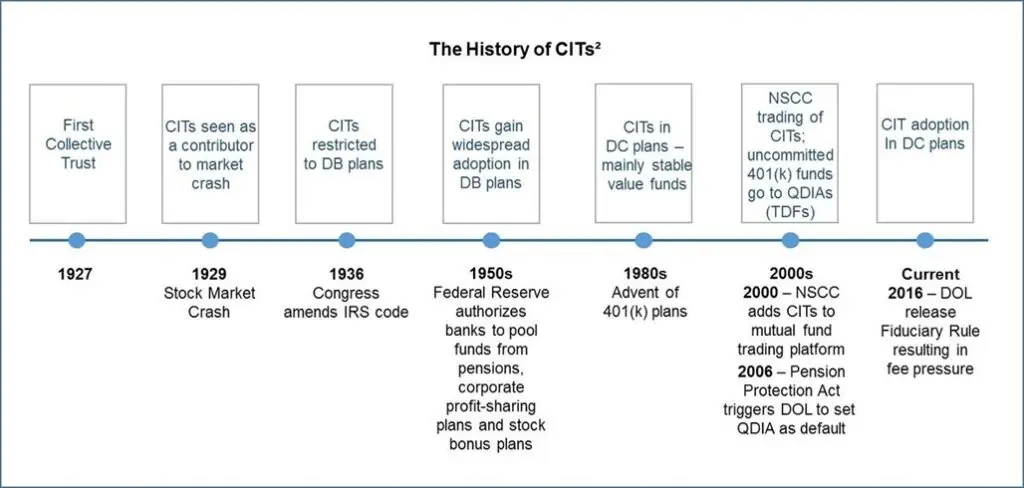Collective Investment Trusts
CITs – The Fastest Growing Investment Vehicle Within 401(k) Plans
For almost a century, collective investment trusts (CITs) have played an important role in the markets. They were originally introduced in 1927.
For the vast majority of their existence, CITs were available only in defined benefit (DB) plans. In 1936 CIT use expanded in DB plans when Congress amended the Internal Revenue Code to provide tax-exempt (deferred) status to CITs. CITs then gained widespread adoption in the 1950s when the Federal Reserve authorized banks to pool together funds from pensions, corporate profit-sharing plans and stock bonus plans. The IRS also granted these plans tax-exempt status.

In the 1980s, 401(k) plans became primary retirement plans and mutual funds became the primary investment vehicle, due to daily valuation. In the 2000s, CITs gained significant traction in defined contribution (DC) plans due to increased ease of use, daily valuation and availability. During this time CITs were also named as a type of investment that qualifies as a qualified default investment alternative (QDIA) under the Pension Protection Act of 2006. From 2009 to 2014, the use of target-date CITs nearly doubled as a percentage of target-date assets, from 29 percent to 55 percent.1
The advantages of CITs are plentiful:
- Lower operational and marketing expenses
- A more controlled trading structure compared to mutual funds
- They’re exempt from registration with SEC, thereby avoiding costly registration fees
On the other hand, CITs are only available to qualified retirement plans and they may have higher minimum investment requirements.
While CITs have traditionally only been available to large and mega-sized plans, continued fee litigation – as well as increased CIT transparency, reporting capabilities and enhanced awareness – has amplified the allure of CITs to plan sponsors across all plan sizes. However, CITs haven’t been widely available to all plans — until now.
Through our strategic partnership with RPAG, a national alliance of advisors with over 35,000 plans and $350 billion in retirement plan assets collectively2, we provide our clients with exclusive access to actively managed, passively managed and target date CITs, featuring top-tier asset managers3 at a substantially reduced cost.
Questions?
Michael Del Re III, AIF®, ChFC®, REBC®
mjdelreiii@fnlonline.com
203.878.8194
fnlonline.com
About Financial Network Limited
FNL was founded to provide personalized investment strategies for individuals and families, and distinctive employee benefit programs for employers. For more than 25 years, we have thrived as an independent, family-owned and operated firm with a consistent mission – to provide comprehensive and innovative client solutions with the highest levels of professionalism and integrity.
1Plan Sponsors Speak With Action. Alliance Bernstein. 2017.
2As of 1/1/2018.
3Top-tier asset managers include BlackRock, Franklin Templeton, T.Rowe Price and Lord Abbett.
The target date is the approximate date when investors plan on withdrawing their money. Generally, the asset allocation of each fund will change on an annual basis with the asset allocation becoming more conservative as the fund nears target retirement date. The principal value of the funds is not guaranteed at any time including at and after the target date.
Collective investment trusts available only to qualified plans and governmental 457(b) plans. They are not mutual funds and are not registered with the Securities and Exchange Commission.
